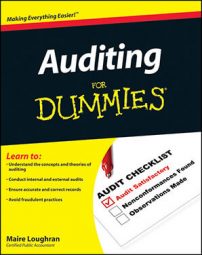During your audit, you need to test management financial statement assertions for fixed and intangible asset transactions. The six assertions that you must attend to when auditing — occurrence, ownership, completeness, authorization, accuracy, and cutoff — are outlined here
Occurrence: Occurrence tests whether the fixed-asset transactions actually took place. To test the occurrence of fixed-asset additions, you should take a sample of fixed-asset additions and vouch them to supporting documents such as vendor invoices, purchase agreements, and titles. Vouching means you take a recorded amount and trace it back to the supporting document.
To test the occurrence of fixed-asset disposals, you select and vouch a sample to supporting documentation. If your audit client sells any fixed assets during the year under audit, ask to see the bill of sale. Use this document to verify that the client has both reduced the asset accounts to zero and correctly reflected the results of the sale on the income statement. Verifying occurrence of purchases and disposals confirms the existence of any assets your client reflects on their balance sheet.
Ownership: The ownership assertion tests whether your audit client actually has a lawful claim to the fixed asset on its balance sheet. You test this assertion by examining title documents or deeds for proof of ownership. You also review lease agreements to make sure that any capitalized leases are included on the balance sheet and that any operating leases aren’t.
Completeness: Completeness evaluates the management assertion opposite to occurrence. This means all the fixed and intangible assets your client owns show up on the balance sheet; none are missing. In fixed-asset management, this assertion directly ties back to the purchasing process. To test this assertion, select a sample of purchase requisitions and trace them back to detailed records of property, plant, and equipment.
Authorization: The authorization step addresses whether your client’s management and staff follow proper internal control or other company authorization procedures when approving the purchase or disposal of fixed assets. To test this assertion, select a sample of fixed-asset additions/disposals and check that all have proper authorization.
Accuracy: Testing accuracy addresses whether transactions are free from error. For example, your client must properly classify depreciation, repair expenses, asset movement, and impairments. Here are some ways to test management assertions for each one when dealing with fixed and intangible assets:
Depreciation: Accuracy involves determining whether the depreciation methods that the company uses conform per generally accepted accounting principles, or GAAP, and are consistent with the prior period. To do so, you recalculate the audit client’s depreciation figures to see whether you come up with the same figure as the client.
Repairs and maintenance: Scan the general ledger listing for this account. Select a sample of larger payments, and vouch the expenses back to the invoices to make sure none of these expenses needs to be capitalized.
Asset movement: This term refers to additions and disposals. Additions are more than likely part of your purchases process. For disposals, get a schedule from the audit client and trace the original cost of the assets disposed of and their associated accumulated depreciation to the accounting records. You can also recalculate any gain or loss on disposal.
Impairments: Basically, an asset is impaired when it no longer produces revenue as it did in the past, which makes carrying its amount on the balance sheet iffy. If you see any fixed assets on your client’s balance sheet that appear to be obsolete or that may be disposed of prior to their estimated useful life, you may have to discuss reducing the balance sheet amount for the asset.
Cutoffs: You must make sure that all transactions have been reported in the proper financial period. You do so by testing purchases and sales of assets for the few days before and after the end of the financial period to make sure fixed-asset transactions are recorded in the right period.

